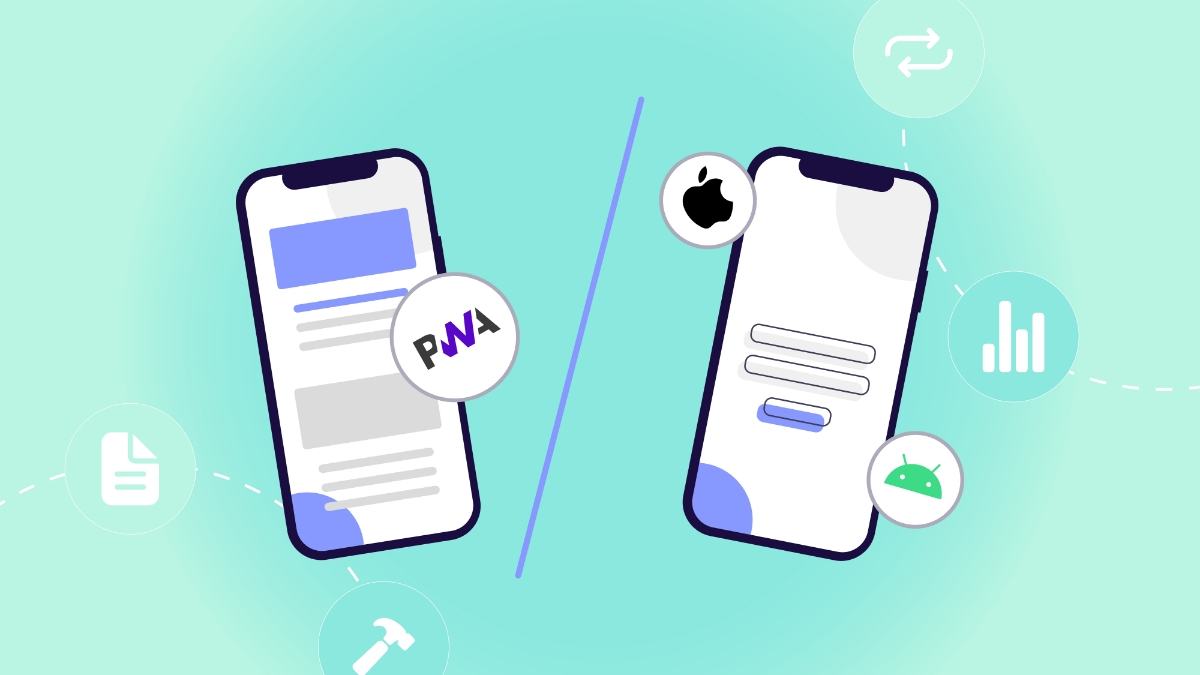PWAs represent a significant shift in how applications are built and experienced. These versatile tools combine the best elements of web and mobile applications, offering a seamless, high-performance experience across various devices and platforms.
Let’s take a look at the characteristics of a PWA, what makes them unique from native apps, and the factors that might influence whether or not you should invest in one.
What is a PWA?
A Progressive Web App (PWA) is a type of application software delivered through the web, built using common web technologies such as HTML, CSS, and JavaScript. The key distinction of PWAs is their ability to provide a more app-like experience while being accessed through a web browser. They combine the best features of web and mobile apps to deliver a seamless and engaging user experience.
Key Characteristics of PWAs:
- Responsive: PWAs work on any device and screen size, adapting their layout to provide an optimal user experience whether on a smartphone, tablet, or desktop.
- Offline Capability: PWAs can function even without an internet connection. This means users can access content and interact with the app offline.
- App-like Experience: PWAs mimic the feel of native mobile apps, including smooth animations, gestures, and navigation.
- Progressive Enhancement: They are designed to work for every user, regardless of their browser or device, by offering a baseline experience for all users and enhancing it for those with more advanced capabilities.
- Push Notifications: PWAs can send push notifications to keep users engaged and informed, even when the app is not open.
- Installation: Users can install PWAs on their devices from the browser, adding them to their home screen just like a native app, but without the need for app store distribution.
Do You Need a PWA?
Deciding whether to invest in a PWA depends on various factors, including your business goals, target audience, and existing digital strategy. Here are some considerations to help you determine if a PWA is right for you:
- Improving User Engagement: If your goal is to increase user engagement and retention, a PWA can be a powerful tool. Features like offline access and push notifications can keep users coming back and interacting with your content.
- Reaching a Broader Audience: PWAs are designed to work on a wide range of devices and browsers. If you want to ensure a consistent experience for all users, regardless of their device or operating system, a PWA can help bridge the gap.
- Cost-Effective Development: Developing a PWA can be more cost-effective than creating separate native apps for different platforms (iOS and Android). Since PWAs use a single codebase for all platforms, you can save time and resources on development and maintenance.
- Increasing Conversion Rates: If you’re looking to drive conversions, such as sales or sign-ups, PWAs can help. They offer a smooth, fast, and engaging user experience, which can lead to higher conversion rates compared to traditional web apps.
- Speed and Performance: PWAs are optimised for speed, which is crucial for user satisfaction. If your current web app is slow or cumbersome, a PWA can offer a more responsive and efficient experience.
- Maintaining a Web Presence: If you don’t have a mobile app but want to offer a similar experience, a PWA can be an excellent solution. It provides many of the benefits of a mobile app without the need for app store submission and updates.
When a PWA Might Not Be Necessary
While PWAs offer numerous benefits, they might not be the best fit for every scenario. Consider the following:
- Specific Platform Features: If your app relies heavily on platform-specific features or hardware (like AR or advanced sensor integrations), a native app might be more suitable.
- Complex Interactions: For highly complex applications that require intricate interactions and performance optimisations, a native app might offer better control and customisation.
- App Store Presence: If having a presence in app stores is crucial for your strategy, native apps might be necessary, as PWAs don’t generally fit traditional app store requirements.
Conclusion
Progressive Web Apps represent a significant evolution in web and mobile technology, offering a versatile and engaging user experience. They are especially valuable for businesses seeking to enhance user engagement, improve performance, and save on development costs. However, the decision to adopt a PWA should be guided by your specific needs and objectives. Assess your requirements, consider your audience, and weigh the benefits to determine if a PWA is the right choice for your digital strategy.
Ready to elevate your digital presence?
At Greenhat, we combine technical expertise with strategic insight to help you harness the full potential of your web presence. Whether you’re considering a Progressive Web App (PWA) or want to enhance your current site, our team is here to help. Connect with Greenhat today to schedule a comprehensive site analysis and strategy session.








